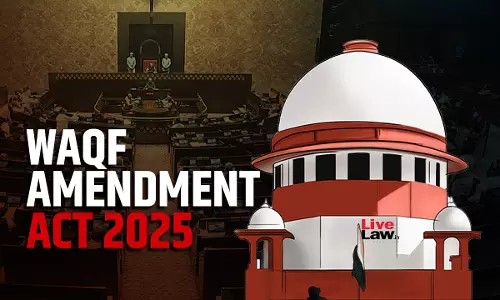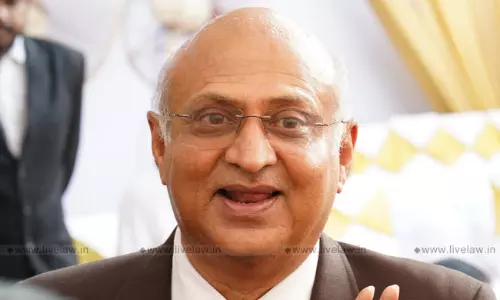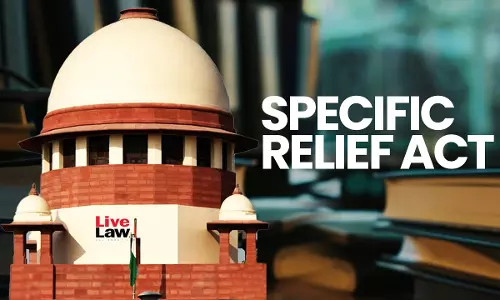[Ayodhya Hearing] [Day 36] : Janmasthan Is Important For Hindus As Visiting It Helps To Attain Moksha, Argues Hindu Parties
![[Ayodhya Hearing] [Day 36] : Janmasthan Is Important For Hindus As Visiting It Helps To Attain Moksha, Argues Hindu Parties [Ayodhya Hearing] [Day 36] : Janmasthan Is Important For Hindus As Visiting It Helps To Attain Moksha, Argues Hindu Parties](https://www.livelaw.in/h-upload/2019/08/08/1500x900_362986-ayodhya-rath-yatra.jpg)
Senior advocate PS Narasimha argued his rejoinder post lunch. The question to be determined, he said, was regarding belief of devotees based. This was proved based on preponderance of probability on the basis of doctrines of the religion, he submitted. According to accounts of witnesses, the right to worship was a civil right and, reiterating the principle of preponderance of probability,...
Senior advocate PS Narasimha argued his rejoinder post lunch. The question to be determined, he said, was regarding belief of devotees based. This was proved based on preponderance of probability on the basis of doctrines of the religion, he submitted. According to accounts of witnesses, the right to worship was a civil right and, reiterating the principle of preponderance of probability, the right was established.
Referring to the Skanda Purana, as religious doctrine, Narasimha cited a shloka where the Janmasthan is mentioned. According to the shloka, the ultimate goal in religion is to attain moksha, and the Shloka "tells us that moksha is attained by visiting the site which is the birthplace of Lord Ram". Asserting the importance of the site, the senior advocate submitted that Lord Ram's birthplace is an important place for a Hindu which ordains him to go there to attain moksha. He further added that since the Skanda Purana existed in pre muslim era, and it records Ram Janmasthan, it means the birthplace already existed before the establishment of the mosque. Countering Rajeev Dhavan's submission he asked, before the advent of mosque, had people not accepted the existence of this place as birth? He concluded his submissions by referring to an travelogue by William Finch, which mentioned the ruins on the land of the disputed structure.
Advocate SK Jain then got up to argue his rejoinder on behalf of Nirmohi Akhara, by referring to the hearing as 20-20 cricket match, since the two counsels arguing before him had wrapped up within 20 minutes due to the paucity of time. CJI Ranjan Gogoi made his displeasure known at such a reference. "We don't appreciate that. We have heard you for four and a half days, yet you say this...Later in the press it will come that this is a 20-20 match...fine, let it be a test match then, keep arguing", he disapproved.
Jain apologized and clarified that he only meant that he would try and complete at the earliest. The Nirmohi Akhara lawyer then started arguing that he did not need to prove title. Justice DY Chandrachud however told him that he must prove they are the shebait. Jain, responded to Sunni waqf board's contention and stated that the temple included both inner and outer courtyard and Akhara had laid claim for both inner and outer courtyards. Justice Ashok Bhushan interjected this time and asked him not to repeat his arguments- "You must reply to the objections made to claims against your shebaiti rights".
SK Jain argued then that because the dispute involved the inner courtyard, they specifically mentioned only the inner courtyard. "That does not mean we concede outer courtyard...We do not consider the inner and outer courtyards as separate", he asserted. "I need not file a suit for the entire area as a part is already under our management." The Akhara was found to be in possession of the outer courtyard when suit was filed for the inner courtyard, he stated. Jain clarified that Nirmohi Akhara was suing in the capacity of shebait on behalf of the deity.
He went on to counter another claim, made by Sunni waqf board, that Hindus placed idols in the inner courtyard in December 1949 as being untrue and alleged that Muslim parties made up the story to create trouble.
Moving on to possession, Jain took the court through the law regarding De facto possession versus de jure possession. Submitting that in case of de facto possession, Art 144 would apply but Art 120 B would not, it was stated that their suit was for possession and despite having de jure possession, de facto possession had gone. " The State took custody of the site, but I have de jure possession as shebait...The burden of proof for ownership lies with other parties." Countering Sunni waqf board's claim over inner courtyard, Jain submitted that they could not stake claim on one part, as the entire structure is one juridical entity.
When Nirmohi Akhara moved on to respond to the argument on limitation, Justice Bobde enquired when they claim the limitation kicks in from. "When the cause of action arises, when attachment was made", responded Jain. The bench seemed to disagree but said they understood his argument.
The Court then allowed Adv PN Mishra half an hour to argue for Sri Ramjanmabhumi Punarudhar Samiti. Dealing with the Skanda Purana, Mishra mentioned Ram Setu. Rajeev Dhavan intervened saying Mishra was putting up new evidence which was not present before. "If we keep accepting these arguments, there would be continuous arguments on vedas, puranas etc.", and submitted that the court must urge Mishra to stick to replying to the arguments advanced by Dhavan. The CJI and Justice Chandrachud concurred and the latter asked where in Skanda Purana was it mentioned that this was the exact birthplace of Lord Ram.
As Mishra began reading the meanings of janmabhoomi and janmasthan from the hindu dictionary, Dhavan again objected and said only the Islam dictionary had been put on record, no one else's. Mishra replied that he had placed it before the trial judge. "That way we'd have to hear Dr. Dhavan's arguments on all of them", retorted CJI Gogoi while pulling up the counsel. "This is a Constitution Bench not because 5 judges are sitting here, but due to the importance and sensitivity of the matter", he said while informing PN Mishra that his time was up.
SK Jain resumed his submissions and argued that the placing of idols inside the dome happened with the backing of the police, not overnight.
Upon Jain questioning how a deity could travel inside from outside, J Chandrachud pointed out that witnesses had said that it happened by magic overnight. Jain's response was that it was difficult to prove who built what, since it dates back to the 16th century.
"I am only arguing on shebaiti rights as it was clear that we were managing since the 1800s", he stated. While SK Jain sought to argue more, the Bench rose while stating that his time was over and that they would read the remaining submissions.
As per the schedule set by the Bench on Monday, September 30, the Hindu parties have completed their rejoinder arguments. Dr Rajeev Dhavan will now argue his response for Sunni waqf board from tomorrow.




